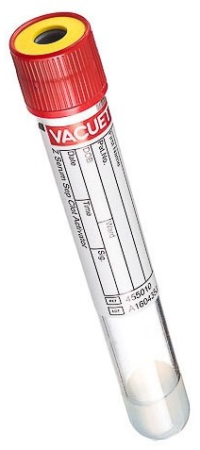
Test Code:
899 - TSH
36127 - TSH with Reflex to FT4
90896 - TSH, Pregnancy
CPT Code(s):
Test Code 899: 84443
Test Code 36127: 84443
Test Code 90896: 84443
Supply: #T157 Red/Yellow SST 8mL
Includes:
Test Code 899: TSH
Test Code 36127: For patients 1 year of age or older, Free T4 will be performed at an additional charge (CPT code(s): 84439) when TSH result exceeds age/gender specific reference range.
Test Code 90890: TSH
Methodology: Immunoassay
Clinical Significance:
Test Codes 899 & 36127: For differential diagnosis of primary, secondary, and tertiary hypothyroidism. Also useful in screening for hyperthyroidism. This assay allows adjustment of exogenous thyroxine dosage in hypothyroid patients and in patients on suppressive thyroxine therapy for thyroid neoplasia.
Test Code 90896: TSH levels are lower during pregnancy, especially during the 1st trimester. Based on recent clinical studies which have shown that even mildly elevated TSH during pregnancy is associated with adverse pregnancy outcomes, the American Thyroid Association has released clinical guidelines which recommend the use of assay-specific and trimester-specific reference intervals.
Additional names:
Test Code 899: Highly Sensitive TSH; TSH, Highly Sensitive; 9/9/96-CHGD Field 25-Bac; 2nd Generation TSH; Thyrotropin; 3rd Generation TSH; Hypersensitive TSH; PEDS TSH; Supersensitive TSH; Thyroid Stimulatin Hormone; TSH3; TSH Highly Sensitive; TSH Ultra-Sensitive; TSH, Delta, Single Specimen; TSH, Psychiatric, Single Specimen
Test Code 36127: Thyrotropin; 3rd Generation TSH; Thyroid Function; Thrrotropin w/ reflex to FT4; TSH Ultrasensitive; TSH w/FT4 Reflex; TSH w/RFX; Ultra TSH w/Rfx to Free T4
Test Code 90896: Pregnancy TSH
Supply: #T157 Red/Yellow SST 8mL
Preferred Specimen: Serum
Preferred Volume: 1mL
Transport Container: Serum Separator Tube (SST)
Transport Temperature: Room Temperature
Specimen Stability: Room Temperature: 7 Days
Reject due:
- Hemolysis
- What are hemolyzed specimens?
- Hemolysis occurs when the red cells are damaged during sample collection causing them to rupture. Hemolyzed serum or plasma is pale pink to red rather than the normal clear straw or pale-yellow color.
- What causes a specimen to be hemolyzed?
- Mixing tubes too vigorously
- Placing tubes in the refrigerator without allowing 30 minutes at room temperature for complete clotting
- Exposure to heat or in a refrigerator that is too cold
- Using a needle with too small of a bore necessary for the venipuncture
- Using too large a tube when using a butterfly needle
- Not allowing sufficient time for alcohol to dry on puncture site
- Leaving the tourniquet on for longer than one minute
- How can hemolyzed specimens be prevented?
- For routine collections, use a 20–22-gauge needle
- Do not remove the needle from the vein with the vacuum tube engaged
- Do not collect a specimen in a hematoma
- Do not centrifuge the specimen for a prolonged period of time
- Draw the sample gently and evenly
- What are hemolyzed specimens?
- Plasma
- Specimens exceeding stability
- Specimens other than serum
- Unlabeled or improperly labeled specimens
For additional supply or collection information, please contact DLO's Customer Service at (800) 891-2917, option 2.
The CPT codes provided are based on AMA guidelines and are for informational purposes only. CPT coding is the sole responsibility of the billing party. Please direct any questions regarding coding to the payor being billed.
